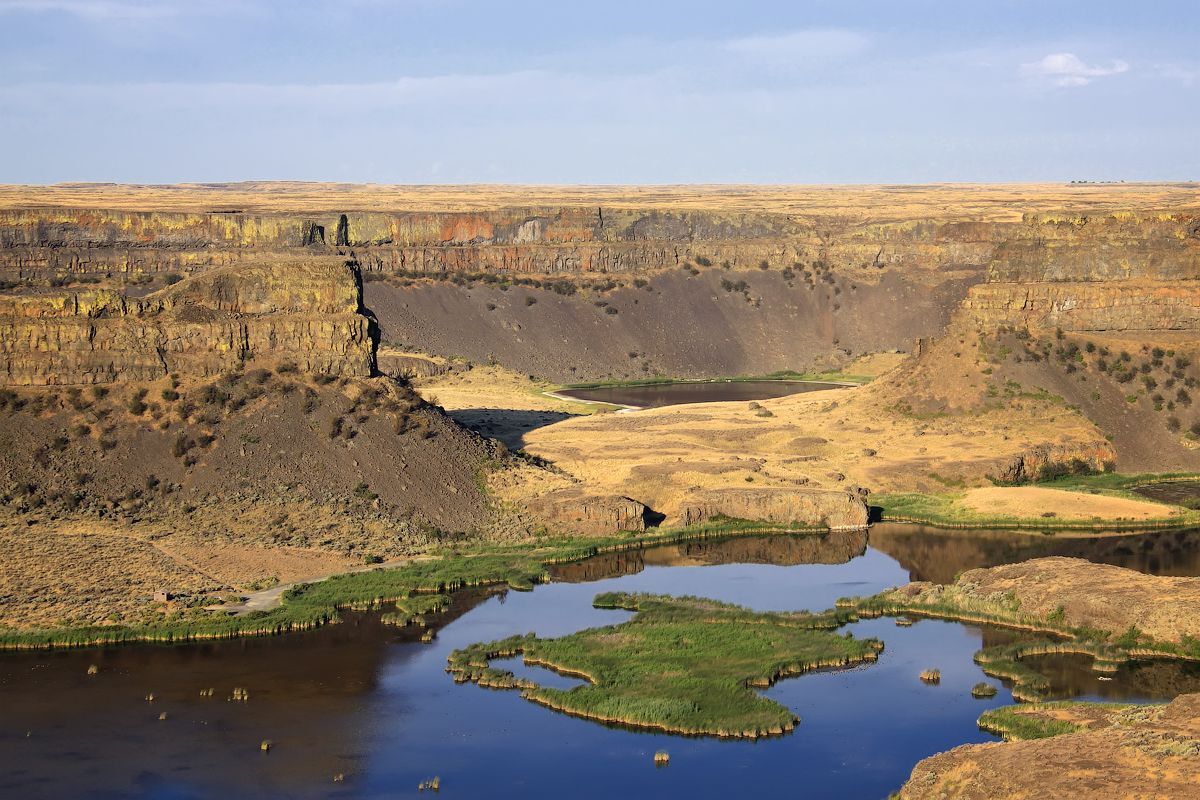Mysteries Behind Washington’s Dry Falls

Have you ever wondered how a waterfall could exist without water? Washington's Dry Falls is one such marvel. Once the largest waterfall on Earth, it now stands as a testament to nature's power and change. Imagine a cascade five times wider than Niagara Falls, now silent and dry. This geological wonder offers a glimpse into the Ice Age floods that shaped the landscape. Visiting Dry Falls is like stepping back in time, where you can see the remnants of a force so powerful it carved out canyons and cliffs. Ready to learn more about this intriguing site? Let's dive into the history and beauty of Dry Falls.
Mysteries Behind Washington's Dry Falls
Dry Falls in Washington is a geological wonder that sparks curiosity. Once a massive waterfall, it now stands as a dry cliff, leaving many to ponder its history. Let's uncover the secrets behind this fascinating site.
The Formation of Dry Falls
Understanding how Dry Falls came to be requires a look back in time. This area wasn't always dry; it was once a powerful waterfall.
Ice Age Floods: Thousands of years ago, during the last Ice Age, massive floods carved out the landscape. These floods, known as the Missoula Floods, were caused by the breaking of ice dams, releasing enormous amounts of water.
Glacial Lake Missoula: The water from the floods originated from Glacial Lake Missoula. When the ice dam broke, the lake's water surged across the land, creating the falls.
Erosion and Sediment: The rushing water eroded the basalt rock, forming the cliffs we see today. Sediments carried by the water were deposited downstream, shaping the surrounding terrain.
The Scale of Dry Falls
The sheer size of Dry Falls is awe-inspiring. To grasp its magnitude, consider these points.
Height and Width: Dry Falls is over 400 feet high and 3.5 miles wide. This makes it larger than Niagara Falls, even though no water flows over it now.
Volume of Water: At its peak, the falls would have seen a flow of 10 times the current flow of all the rivers in the world combined. Imagine the roar and power of such a waterfall!
Comparison to Modern Falls: Comparing Dry Falls to existing waterfalls helps illustrate its grandeur. For instance, Niagara Falls is only about 167 feet high and 1 mile wide.
The Surrounding Landscape
The area around Dry Falls offers more than just the cliffs. The landscape tells a story of its own.
Sun Lakes-Dry Falls State Park: This park surrounds Dry Falls and provides a glimpse into the region's natural beauty. Visitors can hike, camp, and explore the unique terrain.
Umatilla Rock: A prominent feature in the park, Umatilla Rock is a testament to the area's volcanic past. It's a popular spot for hiking and photography.
Deep Lake: Located nearby, Deep Lake is a serene spot for fishing and boating. Its clear waters contrast with the rugged cliffs of Dry Falls.
The Wildlife of Dry Falls
Despite its dry appearance, the area around Dry Falls teems with life. Various species have adapted to this unique environment.
Bird Watching: The cliffs and lakes attract numerous bird species. Eagles, hawks, and waterfowl are commonly seen, making it a bird watcher's paradise.
Mammals and Reptiles: Coyotes, deer, and various reptiles inhabit the region. These animals have adapted to the arid conditions, finding food and shelter in the diverse landscape.
Aquatic Life: The lakes and ponds in the area support fish and amphibians. Species like bass, trout, and frogs thrive in these waters.
Human History and Dry Falls
Humans have been drawn to Dry Falls for centuries. The site holds cultural and historical significance.
Native American Heritage: Indigenous peoples have lived in the area for thousands of years. They left behind artifacts and petroglyphs, offering a glimpse into their lives.
Early Explorers: European explorers and settlers were fascinated by Dry Falls. Their journals and maps provide early descriptions of the site.
Modern Tourism: Today, Dry Falls attracts tourists from around the world. The visitor center offers educational exhibits, and guided tours help explain the site's history and geology.
The Lasting Impact of Dry Falls
Dry Falls isn't just a geological wonder; it's a testament to nature's power. Formed by ancient floods, this site offers a glimpse into Earth's dramatic past. Visitors can explore the massive cliffs, walk along the canyon floor, and imagine the roaring waters that once carved this landscape.
The surrounding area is rich with wildlife and scenic views, making it a perfect spot for hiking and photography. Educational signs provide insights into the geological history, making it a great learning experience for kids and adults alike.
Whether you're a history buff, nature lover, or just looking for a unique adventure, Dry Falls has something for everyone. Its awe-inspiring beauty and fascinating history make it a must-visit destination in Washington. Don't miss the chance to witness this natural marvel and create unforgettable memories.

